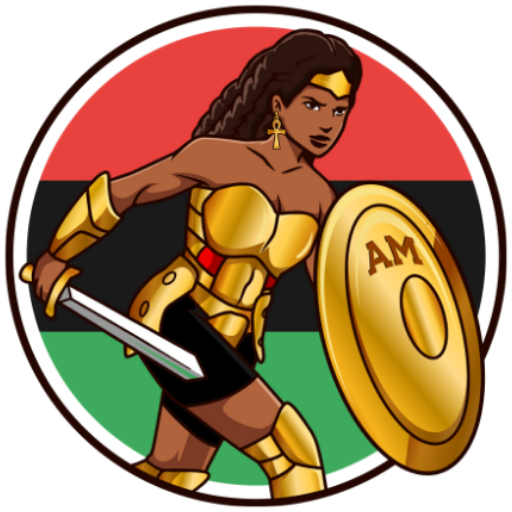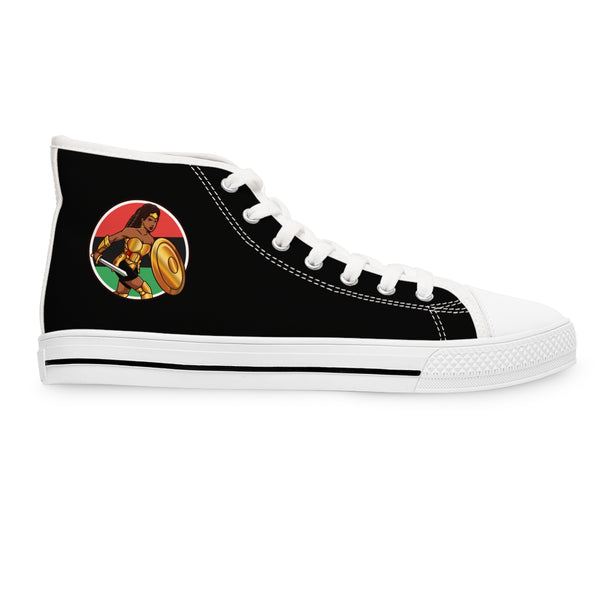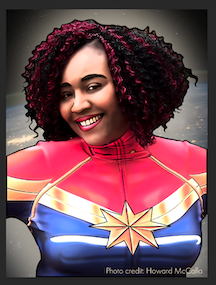
Guest Fest: Balogun Ojetade Discusses Countering Negative Images of Blacks in the Media
Share
The longest-running, most successful propaganda campaign of all time is for black inferiority.
From posters that advertised slaves for sale, to the New Yorker‘s radical “Obama” cover, there has been an unrelenting, powerfully persuasive effort to promote what the brand of black inferiority. Even today, for every positive image of African-Americans, there are 100 negative stereotypes; sadly, many of them perpetrated by Black people.
Advertising came in many, many forms, including any form of communication, such as text, posters, placards, and the like and consists of a clever combination of images and words. Images and words combined are very powerful, and have been used, quite effectively, to convey this whole idea of African-Americans being “less than”; “not as good as”: the myth of Black inferiority.
And the concomitant myth of white superiority.
Black inferiority is a myth that had to be created in order to justify slavery within a democracy. These two contradictions – slavery and democracy – had to be reconciled, and the only thing the good old U.S. of A. could come up with was the declaration and substantiation that slaves were not human.
We must realize that we are not talking about ancient history, either. We have slave narratives that were written in the 1930s. The tragedy and horror of chattel slavery happened only a few generations ago. And the inferiority that was drummed into us through the media – through propaganda – has passed down from generation to generation just like a favorite family recipe.
This sickness must be addressed.
If you have a malignant tumor, you cannot just wait for it to dissipate. It will not just go away. It will spread. The disease of institutionalized racism in the media has been a cancer that we have hoped would just go into remission and now, the whole planet has bought into the myth of Black inferiority, and of white superiority.
We have become insensitive or desensitized to the point we are unconscious of what we see, hear and what is going into our minds. We have become a party to our own brainwashing. We have joined in and become our own victimizers.
In the old days, you had white comedians putting on black cork and basically humiliating and ridiculing Black people. Fast-forward a few years, when we were given this illusion called “progress”. Black comedians said to the white comedians “Hey, you don’t have to ridicule and humiliate us, we’ll do it. We’ll take it from here, boss.”
And they took it from there…and carried it straight to Hell.
Let’s take the use of the word “nigger”, for example. Black comedians took this wicked, destructive word and took ownership of it as if to call ourselves a nigger was empowering, when in fact it continues to damage our psyches and diminish us as human beings.
The historian Carter G. Woodson said that African-Americans have been basically conditioned to go around to the back door, and if there is no back door, we will insist on one.
If you can get a Black comedian to show up on a late-night talk show and act the clown, it’s comforting to those people who say, “See they are a happy people. They aren’t angry with us for five hundred years of slavery and oppression.” It is like approaching a dog you have abused, neglected and chained up in your kitchen for a week, thinking “Boy, I sure hope it doesn’t bite.” And if, instead of tearing out your throat, the dog starts wagging its tail, you breathe a sigh of relief and say “Whew, good dog.”
It is a toxic mix – white supremacy, white superiority, and black inferiority.
This inferiority complex has cause many – if not most – of us to expect very little of ourselves and of others.
There are several reasons for this sad and unfortunate truth. For starters, lower expectations mean fewer disappointments.We have become comfortable with negative behavior; with poor performance.
Recently, my students and I met at a local, Black-owned vegetarian / vegan restaurant for a meeting. The restaurant, scheduled to open at 11:00am, was closed. It was noon when we arrived. This was not the first time this had happened and I suggested we go somewhere else, but everyone – except yours truly – was set on eating at this place.
Time crept on. 12:30pm…12:45pm…1:00pm.
Finally, at 1:15pm, the owners drove up, walked by us without even a “Hello”, let alone an apology for their extreme lateness, and entered the restaurant.
My students and I followed. I asked if they had anything already prepared that we could eat and they informed me that they prepare their food daily, so I would have to wait. I informed the owner that we had already been waiting for an hour and that they were supposed to be open at 11:00. The owner shrugged her shoulders and said “We have lives outside of this restaurant. Don’t you have a life outside of your job?”
As a business owner who goes above and beyond to satisfy my students and those who read my books and watch my films, I was shocked and furious. I told my students that I was leaving and would never spend another dime with those fools. My students all said that we need to give Black businesses second, third and forth chances. And that as “conscious” Black folks we must be even more forgiving.
I said “Consciousness has nothing to do with it! We have to demand excellence from Black businesses and cease this acceptance of Black mediocrity or we will remain mediocre!” I then hugged everyone and left. I have never returned to that restaurant. And never will.
From kindergarten through fourth grade, I attended Sol R. Crown Elementary School in a poor neighborhood on the West Side of Chicago. At Crown, being smart and working hard was interpreted as acting white. Because to be smart, was also to be different. And to be different meant that you were trying to be better than those who were not striving.
When I was in kindergarten, one day my class was counting from one, through ten. My voice seemed to stick out from the rest of the group for some reason. The substitute teacher – a Caucasian woman who appeared to be in her early forties and mean as a junkyard dog fed a steady diet of gunpowder and guinea peppers – seemed to notice too and she singled me to count by myself. “Won…too…th-REE…for…” I said, pronouncing the words carefully and correctly, as my mother and sisters taught me. “…fiv…” The students laughed at the way I properly said five. They also laughed at my “nin” and my “tehn”, saying “It ain’t ‘fiv’, it’s ‘fahv’; it’s not ‘nin’, it’s ‘nahn’; and it shol’ ain’t ‘tehn’, it’s ‘tin’.”
I challenged them and said they were “talking country” (“talking country” means to speak in an unsophisticated manner, usually associated with the drawl of the rural American South) and asked the teacher who was right. The teacher told them I was wrong and that the “country” way they said the numbers was the “proper way for your people to say it.”
And no, this was not in Yazoo, Mississippi in the 1800s. It was 1972 in Chicago, Illinois.
Even today, if a Black person is articulate and does not use slang, some of us will say that person is acting “white”.
The media is directly responsible for this. The perpetuation of stereotypes is always done through print, television, film, radio, music and, now, the internet.
We sing, dance, and make love to catchy beats that endorse, reinforce, and promulgate our most self-destructive habits.
Flip the channel or turn the page and there are the “baby mamas” and “baby daddies” so ubiquitous in common American culture that they become plot points or titles for mainstream comedies and movies.
And there, on the news, backed by respected research, are the products of all this ingrained promiscuity and violence – young Black children, seemingly running amok in urban cities that breed violence.
The syndicated television program Maury, hosted by Maury Povich, is known for its “Who’s Your Daddy?” segments. Much of the content is based on issuing paternity tests to teens and young adults in hopes of determining fatherhood.
Many of Maury’s guests are black, and the sheer number of these cases is damning. Shows like these, along with court television shows that promote the same dysfunction, are very popular.
Millions of viewers are indoctrinated by these images of black family chaos. And we watch these programs like a gory highway car wreck because they involve so many people who look like us.
Blacks not only dance to the beat of family destruction, we patronize films by black producers and directors that reinforce all the bad we’ve been fed about ourselves – first by the white ruling class, and now by our brainwashed brethren.
Whether it’s the Rihanna and Chris Brown domestic violence madness, negative, self-demeaning movies, or characters like those depicted in nearly any Tyler Perry movie – Black relationships and families are seen as hopelessly at odds, dysfunctional, violent, and inadequate.
Yet we accept and share these perceptions without question, qualm or quarrel.
Passionate conversations about “no good black men” among groups of Black women are common. What is a rare occurrence, though, is our willingness to go to the historic root of negative Black male behavior or discuss how fatherless homes help shape the sentiments shared by so many Black women.
Likewise, Black men are not aware of the unconscious motivators that cause them to demean our Sisters. There is no objection raised when these men lament about evil, mean-spirited, materialistic, or impatient Black women, and then expound on why they are better off with white women. Little attention is paid to the daughters these men bring into the world. Not only are they conditioned to live the stereotype of their mothers, many do so in homes with absentee fathers.
It is assumed that Black women are supposed to have a gang of children with multiple men who will eventually abandon them. These women are quickly relegated to “supermom” status, expected to serve as both the foundation and as the Black family’s doormat. This, too, is a topic that receives little discussion, as is the mystery of how and why Black women become enablers, molding Black boys who will someday emulate the actions of their wayward fathers.
At a very young age, Black men and women are inundated with messages that they cannot trust or depend upon one other. Children see images of – and hear comments and jokes about – lazy, greedy, irresponsible, or otherwise flawed Black adults.
These degrading stereotypes are reinforced and enhanced by our negative portrayal of in the media. Black characters have appeared in American films since the beginning of the industry in 1888, but Black actors were not even hired to portray Black people in early works. Instead, white actors and actresses were hired to portray the characters while in “blackface.”
In addition, Black people were purposely portrayed in films with negative stereotypes that reinforced white supremacy over Black people. Since motion pictures have had more of an impact on the public mind than any other entertainment medium in the last ninety years, this has had a tremendous effect on society’s view of Black people.
The media sets the tone for the morals, values, and images of our culture. Many people in this country, believe that the degrading stereotypes of Black people are based on reality and not fiction. Everything they believe about us is determined by what they see on television. After over a century of movie making, these horrible stereotypes continue to plague us today, and until negative images of Black people are extinguished from the media, we will be regarded as second-class citizens.
The Solution
We have not come that far since 1914, when Sam Lucas was the first black actor to have a lead role in a movie for his performance in Uncle Tom’s Cabin.
1915 is a significant date in motion picture history because D.W. Griffith released The Birth of a Nation, which supported the Ku Klux Klan and is possibly the most anti-Black film ever made.
The National Association for the Advancement of Colored People (NAACP) worked very hard to try to ban the film due to its vicious portrayal of Black people as subhuman compared to the glorified Ku Klux Klan. The Birth of a Nation was important because it led to the creation of a new industry that produced “race films” for African-Americans. These films portrayed us in a positive light and addressed many social concerns of the community.
Before “race films,” Black people were nothing more than shuffling, shiny-faced, head-scratching simpletons with bugged out eyes who leaned on brooms and spoke bad English, but after the introduction of “race films,” we were depicted with more dignity and respect.
In order for Black people to ensure that they would have positive roles and stop reinforcing negative stereotypes through film, we had to make our own movies. The same holds true today.
Thus, in 2006, I began to do my part and (finally) put my Columbia College film schooling to use. First, I took roles in independent martial arts films, paying close attention to how the directors, producers and fight choreographers did their jobs. I added their knowledge and experience to my own and, in 2007, produced a film that I wrote and starred in entitled Reynold’s War. I learned a lot about guerilla filmmaking on that shoot, which was as close to Nollywood as one can get without actually going to Africa.
Next, I directed and produced the action-packed drama, A Single Link. This was my first time directing a film and the first day was so stressful that I nearly passed out on the set. We made it through, however, with my wife – who plays the lead character – shooting a grueling – and until then, unheard of – five fights in one day. She was an inspiration to everyone and we all brought our A-Games after that.
A condensed version of A Single Link premiered in August, 2012 to a packed house that loved the film. We are currently working out a deal to bring the film to cable television.
I have now partnered with author and publisher, Milton Davis, in the creation of a Steamfunk (a philosophy or style of writing that combines the African and / or African American culture and approach to life with that of the steampunk philosophy and / or steampunk fiction) television series, Rite of Passage, which is based on Milton’s short story, Rite of Passage. The screenplay, directing and fight / stunt choreography are courtesy of Yours Truly and Milton and I are both producing the series. We are raising funds to complete the film on Indiegogo at http://www.indiegogo.com/RiteOfPassage?a=1217516. A short excerpt from the series can be seen there as well.
I – and my creative partners – will continue to create exceptional works of literature and films in the fantasy, horror and science fiction genres because it is needed…and we love doing what we do. As our passion has proven to be quite contagious (in a good way, like laughter; not in an icky way, like mono or the ebola virus), I am sure you will love reading and watching our work.

Balogun is the author of the bestselling Afrikan Martial Arts: Discovering the Warrior Within and screenwriter / producer / director of the films, A Single Link and Rite of Passage: Initiation.

Balogun is one of the leading authorities on Steamfunk – narrowly defined as “a person, style of dress or subgenre of fiction that seeks to bring together elements of blaxploitation films and merge it with that of Steampunk fiction”. A broader definition is “a philosophy or style of writing that combines the African and / or African American culture and approach to life with that of the steampunk philosophy and / or steampunk fiction” – and writes about it, the craft of writing and Steampunk in general, at http://chroniclesofharriet.com/.
He is author of three novels – MOSES: The Chronicles of Harriet Tubman (Books 1 & 2) (Steamfunk); Redeemer (Science Fiction); and Once Upon A Time In Afrika (Sword & Soul). He is also co-creator of the soon-to-be-released role-playing game, Ki-Khanga™: The Sword & Soul RPG.
Balogun is Master Instructor of the Afrikan Martial Arts Institute and Technical Director of Martial Ministries of America, a non-profit organization that serves at-risk youth. He is also a traditional African priest, actor and conflict resolution specialist, who works and lives in Atlanta, Georgia with his wife, his seven daughters and his son.







